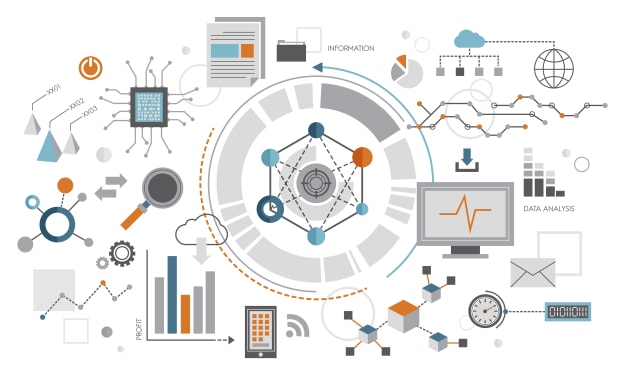Introduction of Descriptive Analysis
An overview of one of the essential tools used to portray behaviors and trends from real events

Imagine you work for the transportation industry, where cost-effective delivery is essential for your company’s success and profitability.
You will probably want to find a way to minimize energy usage through better route planning. You will work hard to solve logistical issues such as incorrect shipping locations.
The good news is you probably already produce massive amounts of data. Unless you have in place a peloton of data analysts and restless dispatchers to decide how to operate your company best, it would be nice to automate this process and build models to provide data-driven decisions for your fleet based on recommended actions, derived from past performance, current conditions and desired results for the future?
It may seem complex at first, but prescriptive analysis, one of the solutions within the so-called Advanced Analytics, is the answer that already exists to make all of this possible.
And today, we will explore one of the essential tools used to portray behaviors and trends from real events, and this tool is called Descriptive analytics.
Descriptive analysis is generally the first manipulation performed in a quantitative study, and its main objective is to summarize and explore the behavior of the data.
This can be done using frequency tables, graphs, and numeric summary measures. Before presenting each of these items, let us first identify the types of variables found in our data.
The fundamental descriptive analysis involves the calculation of simple measures for the composition and distribution of variables. Depending on the type of data, the proportions, rates, proportions, or averages may be the same.
Also, where necessary, as in sample surveys, measures of association between variables may be used to determine whether or not the differences observed between women and men are statistically significant.
The descriptive analysis focuses on understanding whether, behind one or more recurring events, trends or patterns can be mapped out.
Today, with available technology and accumulated knowledge, we can contemplate the most varied phenomena, examine them and, if applicable, draw new conclusions from them.
This is the basis for a descriptive statistical analysis based on real data to understand what is going on and make better decisions by reading it.
In a company, this corresponds to the introductory stage of data management. It gathers information that will then be studied and transformed into subsidies to define the business’s direction.
As the desire to use data and analysis to empower organizations increases, there is still a lack of understanding of the four levels of analysis and the understanding that data and analytics’s primary purpose is to make smarter decisions and help businesses get all organizations points.
Organizations have spent a long time investing money in software and data analysis tools, thinking it would be a magic potion, solving organizational problems, and creating vast amounts of value.
The problem is that most organizations do not even know the four levels of analysis, much less have a strong culture that allows the learning of data literacy, the use of data analysis, and data-based decision-making.
One step that organizations can take to address barriers is to develop a solid understanding of the four levels of analysis and how they interact.
But if you are at the level “what the hell are you talking about?”, here you have a quick recap on what are the following four levels of analysis:
Descriptive analysis
The first level of analysis is one that everyone should be familiar with and where organizations spend most of their time in the analytical field. Still, it should only be the first piece: descriptive analysis, also known as observational analysis or reporting.
This is the first level of analysis, where organizations use dashboards, reports, and so on to report and make data observations.
Diagnostic Analysis
Diagnostic Analytics is the second level, and it is also known as the place the insights come from.
Organizations need to go through observational analysis, analyze reports, and train the workforce to determine why. Helping people to understand that correlation does not mean that causation and empowerment go beyond the nominal value.
This is where the data literacy of data comes into play. When individuals are empowered with data literacy and use it, they analyze the data to dig deeper and find insights.
Predictive analysis
Predictive Analytics is the third level, and this is the level where they spend most of their money.
This is the best-known level, as it predicts future scenarios based on the analysis of database patterns. Thus, it is possible to make more accurate decisions.
The methods used by predictive analysis are statistical and historical data and data mining, and artificial intelligence. It is indicated to project the public's future behaviors and the market and assess fluctuations in the economy and consumption trends.
Prescriptive Analysis
The prescriptive analysis is an elegant way to say that the data will tell you what to do. This should be a target for organizations to reach this level, but it should be part of the overall strategy.
The descriptive analysis gives knowledge that may form the basis for further quantitative analysis. If interpreted correctly, the data may provide useful information that leads to the creation of a hypothesis.
It has a significant role in the business analytics process, providing a sound knowledge base that can be used as a support for further analysis and getting a more reliable diagnosis to follow the predictive and prescriptive steps.
When correctly interpreted, the information and data collected can become powerful insights into creating strategies and solutions within the business plan.
Although some companies still avoid descriptive analysis, this attitude may be a dangerous mistake because it is useful in providing accurate problem reporting.
So, think with me, if these errors and flaws are pointed out initially in the initial phase of the information study, it will not be more comfortable for companies to develop a plan that reverses or even prevents a negative situation in the company? I guess we all know the answer, do not we?
Let us say descriptive analysis works as a facilitator. Based on the company’s historical and current data, the Analytics tools can describe, record, and interpret phenomena without interfering with existing variables.
In this case, managers no longer need to read pages and pages of reports because the most relevant information will be collected in one place. This will save time and effort.
The results are all presented and analyzed so that managers can reach the answers later on. An analysis can be carried out quickly, which helps produce quantitative data to achieve a higher volume of samples.
And these samples are helping to make a decision. It is to analyze all the data in one place and, based on that, to receive insights in less time.
Almost every descriptive analysis is based on research as a starting point based on a questionnaire.
This is, of course, the case where the object being researched can be measured and evaluated based on the answers given by real people.
These surveys may be structured if the questions are the same for anyone who participates in an unstructured study, where feedback dictates the investigation’s direction.
Analysis of statistical data is the basis on which quantitative analysis is based.
By examining the data collected, it is possible to create hypotheses that may or may not be established later.
Therefore, its main advantage is that it is an instrument that imparts impartiality to the study, preventing the formation of value judgments.
It is also the most appropriate method to have a comprehensive view of the phenomenon and collect behavior data.
- The researcher has a high level of objectivity and neutrality.
- It is considered expansive in comparison with other quantitative methods and offers a broad view of the phenomenon.
- It is the best way to collect data that describes relationships and shows the real world.
- Knowledge of descriptive analysis helps to understand the subject and interpret more complex statistical models for simple models.
- This type of study gives the researcher the flexibility to use quantitative and qualitative data to determine its characteristics.
On the other hand, descriptive statistical analysis has certain limitations that need to be considered.
One is the sample used, which, if not well selected, may lead to confusing or even untrue reactions.
By the way, questionnaires used for data collection may also lead to conceptual errors if they are poorly designed and therefore compromise the investigation.
Furthermore, it is not always valid in case studies to draw general conclusions from a single occurrence.
The disadvantages of the descriptive analysis are as follows:
- The respondents’ confidentiality and lack of truthfulness are some of the primary deficiencies of the descriptive analysis.
- If the survey questionnaire is not correctly and carefully designed, there may be errors in the investigation’s overall outcome.
- If the researcher chooses only information that supports his or her hypothesis and ignores the part of the data that does not fit, it may lead to research deviations and errors.
- If a case study is used for a descriptive research project, it isn’t easy to generalize based on a single case and draw general conclusions.
- Prejudgment of the investigator may have an impact on the actions taken during the investigation.
See, then, how to structure the descriptive analysis step by step in a simplified way.
Identify the problem
The first step is to identify a problem or question which may be the subject of an investigation. Plant growth, for example, is one of those possibilities, but it can also be a matter of understanding how digital marketing drives sales.
Collect the data
Let us say, then, that you want to understand the relationship between your sales and your company’s marketing efforts. Taking this question as a starting point, it is time to collect the data used to describe the link.
Analyze your data
The data, by itself, does not say it all. It needs to be worked on, and they need to be structured with appropriate statistical tools.
Present your data
After processing the data, it can be presented and, from there, it can lead to conclusions-or new questions. It will depend on how the analysis was conducted from the outset and how the data was structured.
Interpret and analyze the results.
Once reality has been tested using the appropriate statistical tools, it can be interpreted. Imagine that you have discovered that digital marketing and sales are related. With this new information, you will make much more efficient (and accurate) decisions about your business.
Conclusion
In this text, you learned what descriptive analysis is and how it can be vital for your business, and some practical steps to put into practice.
The entry of prescriptive models in business environments is a path of no return. In an increasingly competitive environment and products that are easily “copied,” creating value in your offer is not an easy task.
Currently, virtually all business segments can extract information to support decision-making.
Key takeaways
Here you have some key-points you should remember about Prescriptive Analytics:
- The descriptive analysis focuses on understanding whether, behind one or more recurring phenomena, trends or patterns can be mapped out.
- One step that organizations can take to address barriers is to develop a solid understanding of the four levels of analysis and how they interact.
- When individuals are empowered with data literacy and use it, they analyze the data to dig deeper and find insights.
- Predictive Analytics helps to predict future scenarios based on the analysis of database patterns.
- Thus, it is possible to make more accurate decisions.
- One of the disadvantages of the descriptive analysis is that prejudgments may impact the investigation's actions.
- Five steps to developing a prescriptive analysis can be: Identify the problem, collect the data, analyze the data, present the data and interpret and analyze the results.
If you want to go further on your learning journey, I’ve prepared for you an amazing list with more than 60 training courses about AI, Machine Learning, Deep Learning, and Data Science that you can do right now for free:
- What is Predictive Analytics, and how can you use it today?
- 5+1 ways Predictive Analytics can be applied in your business
- What is Prescriptive Analytics, and what can it do for your business?
- These are some of the best Youtube channels where you can learn PowerBI and Data Analytics for free.
Also, I’ve just published some very interesting ebooks on Amazon, and I’m sure that at least one of them may be interesting for you… have a look:
- AI, Robotics and Coding (for Parents): A practical guide for analog parents with digital kids
- The Terminator paradox: How neuroscience can help us to understand Empathy and the fear of Artificial Intelligence
- Artificial Intelligence from A to Z: Demystifying the essential concepts of AI
- A.I. in 2020: A Year writing about Artificial Intelligence
Copyright: This article was originally published by me on medium.com:
About the Creator
Jair Ribeiro
A passionate and enthusiastic Artificial Intelligence Evangelist who writes about people's experiences with technology and innovation.






Comments
There are no comments for this story
Be the first to respond and start the conversation.